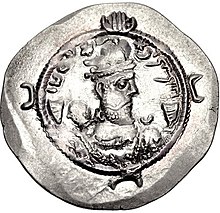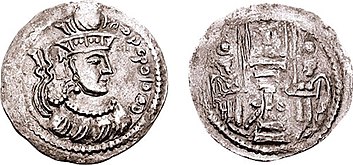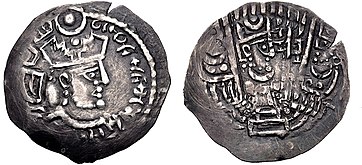利用者:Lin Xiangru/sandbox
サーサーン朝の通貨はサーサーン朝(224年〜651年)が鋳造した貨幣(主に硬貨)である。古代末期において、サーサーン朝はローマ帝国と並んで、重要な貨幣発行国であった[1]。そのためサーサーン朝の硬貨は他国にも影響を及ぼした[2][1]。サーサーン時代の研究にとって、硬貨は極めて重要な一次資料であり、美術史においても極めて重要なものである[2][3]。Sylloge nummorum Sasanidarumはサーサーン朝の通貨についての最も重要な一次資料である[2]。
概説
[編集]


サーサーン朝で主に流通していた硬貨はドラクマ硬貨(中期ペルシア語:drahm)である。前王朝アルサケス朝でも導入され、サーサーン朝初代シャーハンシャー(以下王とする)アルダシール1世(在位:224年〜242年)の鋳造以降サーサーン朝でも代々鋳造された[2][4]。直径259 〜30mm、重さ約4グラムと大型で薄く、当時としては目新しい貨幣である。高純度の銀製で、サーサーン朝のすべての王が大量に生産した。また補助通貨にあたる、単位以下の銀貨も発行されている[2][3]。ヘミドラクマ(0.5ドラクマ)、オボルス(1/6ドラクマ)、さらにはテトラドラクマ(4ドラクマ)などがある[3]。アルダシール1世は、出身地ペルシス(パルス)の既存の通貨制度から、ヘミドラクマとオボルズをそのまま受け継いだと思われる[3]。銅貨やまれにではあるが鉛貨も発行された。
しかし、テトラドラクマは、ほとんど銅製で銀の含有量が僅かであったために、サーサーン朝初期のバハラーム1世(在位:271年〜274年)の治世には不評となっていた[4]。ヘミドラクマも同様にサーサーン朝初期のみ流通していた[4]。オボルズやヘミオボルズは比較的長い間使用されてはいるが、実際は即位式での下賜品、民衆への施しといった特別な儀式の際に散発的に使用されるもので、日常的に使うものではなかった[4]。そのような不人気を受け、ヘミドラクマとテトラドラクマはバハラーム2世(在位:274年〜293年) 274-93)の治世下で廃止された。オボルズの派生硬貨であるダング(dang、中期ペルシア語)は、6世紀初頭のカワード1世の治世の終わりまで鋳造された[4][5]。
金貨は限られた量しか発行されず、その鋳造目的も「宣伝や、ローマ帝国、クシャーナ朝の金貨との競合」であった[2]。ディナール(中期ペルシア語:dēnār、ラテン語のdenarius aureusに由来)金貨は、初代アルダシール1世が発行した[6][3]。アルサケス朝では、金貨の発行されている形跡があまり見つかっていない[3]。シャープール3世の治世(在位:383年〜388年)まで、サーサーン朝の金貨の重さは7〜7.4グラムだった[6]。また金貨以上に、銅貨の鋳造は非常に少なかった [5]。
400年にわたるサーサーン朝の統治下で、硬貨の鋳造権はサーサーン王家のみの特権であり、帝国全土で同一の意匠の硬貨が使用されたことは、サーサーン朝がサーサーン家の権威が帝国全土に及んでいたを示す[2][3]。税金の支払いの他に、どのような状況で硬貨が貨幣として使われたかは不明である[2]。しかし、大半の硬貨は兵士に対する給料として使っていたことは知られている[4]。Philippe Gignoux(フランス語版)とマイケル・ベイツによれば、シャープール2世(在位:309年〜379年)とペーローズ1世(在位:459年〜484年)の治世下では、多数の軍事作戦を行っているため、必然的に硬貨の発行量も増えているはずだと主張している[4]。実際に、カワード1世・ホスロー1世(在位:531年〜579年)・ホスロー2世(在位:590年〜628年)といった多数の戦闘を行っていた時期の硬貨は多数見られる[4]。その硬貨はローマ帝国と同様に「正確でよく組織された工程」に従って全てを手作業で鋳造された[3]。
図像と様式
[編集]サーサーン朝の硬貨は3世紀から7世紀にわたって同様の図像学をとどめていた。しかし、様式の観点からは「肖像や裏面の文様は次第に記号化するようになった」と指摘されている。Rebecca DarleyとMatthew Canepaによると[2]、
Coins usually bore the royal portrait on the obverse and a fire altar with two attendants on the reverse, Sasanian coins contained multiple rims, and late Sasanian coins characteristically included astral symbols outside the rims. Legends were in Pahlavi. They include the name and titles of the King of Kings on the obverse and on the reverse the phrase ‘fire of (name of king)’ and, at times, a slogan. Minting location is occasionally indicated. Each king adopted a personal crown with divine and astral symbols. These were, by and large, unique to him. Exceptions are in cases of an initial co-regency (e.g. Ardashir I and Shapur I) and in the late Sasanian period when crowns become very stylized and often similar. If a king suffered a serious defeat, he might adopt a new crown (e.g. Narseh).
シンド製の硬貨
[編集]
シンド製のサーサーン朝の通貨とは、現在のパキスタン南部のシンドで325年から480年、すなわちシャープール2世からペーローズ1世までの統治期間に鋳造された一連の貨幣である[7]。これらの貨幣はそれ以前にも引き継がれていたいくつかの貨幣の特徴を持っている。クシャーノ・サーサーン朝の硬貨とまとめて、インド・ササニアン(Indo-Sasanian)とも呼ばれる[8]。これらの貨幣もサーサーン朝の経済に重要な役割を果たした。
Sasanian coinage of Iberia (Georgia)
[編集]Although various hoards have been found in what is present-day Georgia containing regular Sasanian coinage, no local mint mark has been identified thus far for these regular Sasanian coins. However, so-called Kartvelo-Sasanian coins were produced locally in Kartli during the later period of Sasanid suzerainty and rule over central-eastern Georgia (Iberia of the classical authors), that is, in the late 6th and first half of the 7th century. As all extant coins of this type are decorated on the obverse with an image of either Hormizd IV or Khosrow II, there are no Kartvelo-Sasanian coins that predate Hormizd IV's rule (which started in 579). The production of Kartvelo-Sasanian coins commenced after the suppression of the Iberian monarchy by the Sasanids, dated by Cyril Toumanoff to c. 580.[9]
Kartvelo-Sasanian coins are usually decorated with asomtavruli letters and/or monograms. These monograms usually represented the names of the prominent and contemporaneous eristavis and presiding princes (eristavta-mtavaris) of Iberia. The earliest Kartvelo-Sasanian coins, as part of the first phase, were inscribed JO, which according to Stephen H. Rapp Jr translates as “O, Cross”. Once the Principality of Iberia was firmly established, the inscriptions, in this second phase, shifted to monograms which mentioned the name of the presiding princes. Examples amongst such are GN and GRG, i.e. "Gurgen/Guaram" respectively; both abbreviations are identified with prince Guaram I ((在位: [[{{{1}}}年]] - [[{{{2}}}年]]) 588-590). Presiding princes who followed after this phase were even bolder in the presentation of their religious affiliation. In this third and final phase of Kartvelo-Sasanian coins a small cross can be distinguished as a replacement for the sacred Zoroastrian flame atop the fire altar. This series commences with the abbreviation SPNS, i.e. "Stepanoz I", positioned around the image of the Sasanian Shahanshah Hormizd VI. The text does not obstruct the reading of the typically used Middle Persian legend. These adaptations develop further during Stepanoz I's reign (590–627), or perhaps during the reign of Stepanoz II (642–650). In this sub-phase, the full inscription of the name "Stepanoz" can be viewed on both sides of the head of the Sasanian Shahanshah, and the Middle Persian inscription depicting the name and regnal year of the Shahanshah is eliminated.[10]
-
Sasanian type coin of prince Guaram I, with obverse bust of Hormizd IV and asomtavruli inscription GRG, i.e. Gurgen
-
Sasanian type coin of prince Stephen I, with obverse bust of Khosrow II and asomtavruli inscription STEP'ANOS
各地への影響
[編集]DarleyやCanepaによると、ササン朝の硬貨は、特に中央アジアや中国との貿易で広く流通したため、エフタルやキダーラ朝などのサーサーン朝に隣接する勢力で鋳造された貨幣のモデルとなった[2]。ムスリムによってサーサーン朝が征服された後も、ウマイヤ朝は貨幣にサーサーン朝の貨幣の特徴が見られるが、アラビア語の銘を加えている独自面も見られる[2]。ただし、この時期の貨幣の中にはアラビア語の文字が刻まれていないものもあった[11] 。これらの貨幣の特徴をアラブ・ササニアン様式と呼ぶ。サーサーン朝の中心地で鋳造され、サーサーン朝の貨幣で常に描かれたゾロアスター教の象徴火の祭壇が描かれている[2][11]。ウマイヤ朝カリフアブドゥルマリク(在位:685年〜705年)は「像を用いない」新たなイスラームのディルハム銀貨を鋳造したが、銀の構成割合や分厚い側面などといったサーサーン朝の特徴を引き継いでいる[2]。
-
5世紀頃のフン族の硬貨。シンド製のサーサーン朝の貨幣の影響を受けている。
-
8世紀初期のドラクマ銀貨。ソグディアナのブハラ・フダーで鋳造された。30mm、3.08グラム。裏面には火の祭壇に王の頭が描かれていて、従者の姿は見当たらない。
インド・ササニアン様式の硬貨
[編集]インドには「インド・ササニアン様式」と呼ばれる形式の硬貨がある。サーサーン朝の硬貨のデザインのうち、幾何学的文様を派生させたものであり、西暦530年頃から西暦1202年頃まで流通した。グルジャル族のプラティハーラ朝、チャウルキヤ朝、パラマーラ朝、パーラ朝の間で使用されていた。インド・ササニアン様式の硬貨は、表面の王の絵については、単純化され幾何学的文様になっており、裏面には、従者がいるときもいないときもあるが火の祭壇のデザインが幾何学的な文様として描かれている[19][20]
-
グルジャラ同盟(Gurjara Confederacy)の硬貨。シンド製の硬貨がモデルとなっていて、およそ570年から712年に鋳造された。
-
チャウルキヤ朝-パラマーラ朝の硬貨。およそ950年から1050年のもの。Chavda(チャバダ)朝の硬貨をさらに様式化しておる。インド・ササニアン様式の特徴の一つである右向きの肖像や火の祭壇と装飾品、その周りには小粒が描かれている[22]。
各皇帝の貨幣
[編集]- アルダシール1世 (224年-241年)
- シャープール1世 (241年-272年)
- ホルミズド1世 (272年-273年)
- バハラーム1世 (273年-276年)
- バハラーム2世 (276年-293年)
- バハラーム3世 (293年)
ナルセ1世
[編集]ナルセ1世(293年-302年)の硬貨に刻まれた称号は、「 Mazdēsn bay Narsē šāhān šāh Ērān ud Anērān kēčihr az yazdān ("マズダーを崇拝する神聖なるナルセ、イラン(人)と非イラン(人)の諸王の王かつ、神々に由来する姿と輝きを持つ者)」であった[23][24]。またナルセの硬貨の意匠は、主に3つに分類できる。1つ目と2つ目の硬貨では、ナルセがパルメット柄の王冠をかぶっているのに対して、3つ目の硬貨では、薄板状の王冠をかぶっていて、それぞれ髪型が異なる[25]。
-
1つ目の種類のディナール金貨
-
2つ目の種類のディナール金貨
-
3つ目の種類のドラクマ硬貨
- ホルミズド2世 (302年-309年)
アードゥルナルセ
[編集]- シャープール2世 (309年-379年)
- アルダシール2世 (379年-383年)
- シャープール3世 (383年-388年)
- バハラーム4世 (388年-399年)
- ヤズデギルド1世 (399年-420年)
- バハラーム5世 (420年-438年)
- ヤズデギルド2世 (438年-457年)
ホルミズド3世
[編集]ホルミズド3世(457年-459年)の硬貨は未発見[27]。
- ペーローズ1世 (459年-484年)
- バラーシュ (484年-488年)
- カワード1世 (488年-497年、499年-531年)
- ジャーマースプ (497年-499年)
- ホスロー1世 (531年-579年)
- ホルミズド4世 (579年-590年)
バハラーム6世
[編集]

バハラーム6世(バハラーム・チョービン、590年〜591年)はホルミズド4世の対立王として即位した。同時に硬貨の鋳造を始めたが、バハラームの即位1年目には、ほとんどの地域がホルミズド4世の硬貨を継続して鋳造していた。サーサーン朝の各地では反逆者バハラームの統治を認められなかったことを示している。在位2年目でも硬貨の鋳造は、彼の勢力基盤レイイやホラーサーンのみに限られている。
- ホスロー2世 (590年-628年)
- ヴィスタム (591年-595年)
- カワード2世 (628年)
- アルダシール3世 (628年-630年)
- ボーラーンドゥフト (630年-631年、女帝)
- ホルミズド5世(630年-631年)
- ペーローズ2世
- ホスロー4世
- アーザルミードゥフト (631年-632年、女帝)
- ヤズデギルド3世 (632年-651年)
関連項目
[編集]脚注
[編集]- ^ a b Darley 2018, p. 1044.
- ^ a b c d e f g h i j k l m Darley & Canepa 2018, p. 367.
- ^ a b c d e f g h Schindel 2005.
- ^ a b c d e f g h Gignoux & Bates 1995a, pp. 424–428.
- ^ a b Album, Bates & Floor 1992, pp. 14–41.
- ^ a b Gignoux & Bates 1995b, pp. 412–416.
- ^ Schindel, Nikolaus; Alram, Michael; Daryaee, Touraj; Pendleton, Elizabeth (2016) (英語). The Parthian and Early Sasanian Empires: adaptation and expansion. Oxbow Books. pp. 126–129. ISBN 9781785702105
- ^ Ray, Himanshu Prabha (2019) (英語). Negotiating Cultural Identity: Landscapes in Early Medieval South Asian History. Taylor & Francis. pp. 177–178. ISBN 9781000227932. オリジナルの2023-11-02時点におけるアーカイブ。 2024年1月2日閲覧。
- ^ Rapp 2014, pp. 323–329.
- ^ Rapp 2014, pp. 326–329.
- ^ a b Bates 1986, pp. 225–229.
- ^ Braarvig, Jens (2000) (英語). Buddhist Manuscripts (Vol.3 ed.). Hermes Pub.. p. 257. ISBN 9788280340061
- ^ “For one of these coins”. 2023年7月9日時点のオリジナルよりアーカイブ。2019年4月4日閲覧。
- ^ Tandon, Pankaj (2013). “Notes on the Evolution of Alchon Coins”. Journal of the Oriental Numismatic Society (216): 24–34. オリジナルの2023-05-19時点におけるアーカイブ。 2018年7月8日閲覧。.
- ^ “CNG Coins”. 2019年4月4日時点のオリジナルよりアーカイブ。2019年4月4日閲覧。
- ^ Verma, Thakur Prasad (2018) (ヒンディー語). The Imperial Maukharis: History of Imperial Maukharis of Kanauj and Harshavardhana. Notion Press. p. 264. ISBN 9781643248813
- ^ Sircar, D. C. (2008) (英語). Studies in Indian Coins. Motilal Banarsidass. p. 376. ISBN 9788120829732. オリジナルの2024-01-02時点におけるアーカイブ。 2019年10月31日閲覧。
- ^ Tandon, Pankaj (2013). Notes on the Evolution of Alchon Coins Journal of the Oriental Numismatic Society, No. 216, Summer. Oriental Numismatic Society. pp. 24–34. オリジナルの2019-08-09時点におけるアーカイブ。 2019年10月31日閲覧。 also Coinindia Alchon Coins (for an exact description of this coin type) Archived 2019-08-09 at the Wayback Machine.
- ^ Ray, Himanshu Prabha (2019) (英語). Negotiating Cultural Identity: Landscapes in Early Medieval South Asian History. Taylor & Francis. pp. 162–163. ISBN 9781000227932. オリジナルの2024-01-02時点におけるアーカイブ。 2024年1月2日閲覧。。
- ^ "The Indo-Sassanian coins, also termed as Gadahiya and circulated from 600 to 1200 A.D., are found in good numbers from Ahmadahad, Banaskantha, Bhavanagar, Junagarh, Kaira, Kutch, Mehsana, of Gujarat." in (英語) The Journal of Academy of Indian Numismatics & Sigillography. Academy of Indian Numismatics & Sigillography.. (1988). p. 145. オリジナルの2024-01-02時点におけるアーカイブ。 2024年1月2日閲覧。
- ^ Smith, Vincent Arthur; Edwardes, Stephen Meredyth (1924). The early history of India : from 600 B.C. to the Muhammadan conquest, including the invasion of Alexander the Great. Oxford : Clarendon Press. p. Plate 2
- ^ Post-Gupta (Chaulukya-Paramara) coin Archived 2017-09-04 at the Wayback Machine., Classical Numismatic Group.
- ^ Schindel 2013, p. 836.
- ^ Shayegan 2013, p. 805.
- ^ Weber 2016.
- ^ Schindel, Nikolaus (2013). “Sasanian Coinage”. In Potts, Daniel T.. The Oxford Handbook of Ancient Iran. Oxford University Press. p. 815. ISBN 978-0199733309
- ^ Shahbazi, A. Shapur (2004). "Hormozd III". In Yarshater, Ehsan (ed.). Encyclopædia Iranica, Volume XII/5: Homosexuality III–Human migration II. London and New York: Routledge & Kegan Paul. pp. 465–466. ISBN 978-0-933273-79-5。
参考文献
[編集]- Album, Stephen; Bates, Michael L.; Floor, Willem (1992). "COINS AND COINAGE". Encyclopaedia Iranica, Vol. VI, Fasc. 1. pp. 14–41.
- Bates, Michael (1986). "ARAB-SASANIAN COINS". Encyclopaedia Iranica, Vol. II, Fasc. 3. pp. 225–229.
- Darley, Rebecca; Canepa, Matthew (2018). "coinage, Persian". In Nicholson, Oliver (ed.). The Oxford Dictionary of Late Antiquity. Oxford: Oxford University Press. ISBN 978-0-19-866277-8。
- Darley, Rebecca (2018). "money". In Nicholson, Oliver (ed.). The Oxford Dictionary of Late Antiquity. Oxford: Oxford University Press. ISBN 978-0-19-866277-8。
- Gignoux, Philippe; Bates, Michael (1995b). "DINAR". Encyclopaedia Iranica, Vol. VII, Fasc. 4. pp. 412–416.
- Gignoux, Philippe; Bates, Michael (1995a). "DIRHAM". Encyclopaedia Iranica, Vol. VII, Fasc.4. pp. 424–428.
- Rapp, Stephen H. Jr (2014). The Sasanian World through Georgian Eyes: Caucasia and the Iranian Commonwealth in Late Antique Georgian Literature. Routledge. ISBN 978-1472425522
- Schindel, Nikolaus (2005). "SASANIAN COINAGE". Encyclopaedia Iranica.
- Weber, Ursula (2016). "Narseh". Archived copy. Encyclopaedia Iranica. 2019年5月29日時点のオリジナルよりアーカイブ。2017年5月4日閲覧。
- Schindel, Nikolaus (2013). “Sasanian Coinage”. In Potts, Daniel T.. The Oxford Handbook of Ancient Iran. Oxford University Press. ISBN 978-0199733309
- Shayegan, M. Rahim (2013). “Sasanian Political Ideology”. In Potts, Daniel T.. The Oxford Handbook of Ancient Iran. Oxford University Press. ISBN 978-0199733309
関連文献
[編集]- Howard-Johnston, James (2014). “The Sasanian state: the evidence of coinage and military construction”. Journal of Ancient History 2 (2): 144–181. doi:10.1515/jah-2014-0032.
- Schindel, Nikolaus (2013). “Sasanian Coinage”. In Potts, Daniel T.. The Oxford Handbook of Ancient Iran. Oxford University Press. pp. 814–840






![初期アルハン・フン(英語版)の硬貨。シャープール2世の硬貨がモデルとなっていて、およそ400年〜440年のものと記されている[12][13][14][15]。](http://upload.wikimedia.org/wikipedia/commons/thumb/0/05/Alchon_Huns._Anonymous._Circa_400-440_CE_Imitating_Sasanian_king_Shahpur_II.jpg/362px-Alchon_Huns._Anonymous._Circa_400-440_CE_Imitating_Sasanian_king_Shahpur_II.jpg)
![グプタ文字で銘が刻まれている、フン族の王ミヒラクラ(英語版)の硬貨。裏面:サーサーン朝の硬貨に特徴的な、火の祭壇の両隣に従者がいて、周りの点線の縁取りがある文様[16][17][18]。](http://upload.wikimedia.org/wikipedia/commons/thumb/7/72/Mihirakula_of_the_Alchon_Huns.jpg/346px-Mihirakula_of_the_Alchon_Huns.jpg)




![カナウジの王で、プラティーハーラ朝の君主ボージャ1世(ミヒラ・ボージャ)の硬貨。およそ850年から900年のもの。表面:ヴィシュヌ神の化身(アヴァターラ)である、猪頭のヴァラーハ。裏面:サーサーン朝時代の硬貨の特徴と似ている。銘:アーディーヴァラーハ[21]](http://upload.wikimedia.org/wikipedia/commons/thumb/8/84/Gurjara-Pratihara_coinage.jpg/198px-Gurjara-Pratihara_coinage.jpg)
![チャウルキヤ朝-パラマーラ朝の硬貨。およそ950年から1050年のもの。Chavda(チャバダ)朝の硬貨をさらに様式化しておる。インド・ササニアン様式の特徴の一つである右向きの肖像や火の祭壇と装飾品、その周りには小粒が描かれている[22]。](http://upload.wikimedia.org/wikipedia/commons/thumb/2/24/Chaulukya-Paramara_coin_circa_AD_950-1050.jpg/200px-Chaulukya-Paramara_coin_circa_AD_950-1050.jpg)


